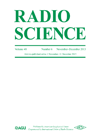Radio Science
Topic: Physics
 From HandWiki - Reading time: 2 min
From HandWiki - Reading time: 2 min
 | |
| |Subject |Discipline}} | Radio science |
|---|---|
| Language | English |
| Edited by | Sana Salous |
| Publication details | |
Former name(s) | Journal of Research of the National Bureau of Standards, Section D: Radio Science (1964-1965); Journal of Research of the National Bureau of Standards, Section D: Radio Propagation (1959-1963)[1] |
| History | 1966–present |
| Publisher | Wiley-Blackwell on behalf of the American Geophysical Union and the International Union of Radio Science (United States) |
| Frequency | Quarterly |
| 1.678 (2022) | |
| Standard abbreviations | |
| ISO 4 | Radio Sci. |
| Indexing | |
| CODEN | RASCAD |
| ISSN | 0048-6604 (print) 1944-799X (web) |
| LCCN | 86642786 |
| OCLC no. | 53479878 |
| Links | |
Radio Science is a quarterly peer-reviewed scientific journal published by Wiley-Blackwell on behalf of the American Geophysical Union and co-sponsored by the International Union of Radio Science.[2] It contains original scientific contributions on radio-frequency electromagnetic propagation and its applications (radio science). Its full aims and scope read:[3]
Contributions covering measurement, modelling, prediction and forecasting techniques pertinent to fields and waves - including antennas, signals and systems, the terrestrial and space environment and radio propagation problems in radio astronomy - are welcome. Contributions may address propagation through, interaction with, and remote sensing of structures, geophysical media, plasmas, and materials, as well as the application of radio frequency electromagnetic techniques to remote sensing of the Earth and other bodies in the solar system.
Volumes for the years 1966 through 1968 were issued by the Environmental Science Services Administration (ESSA), the precursor of the National Oceanic and Atmospheric Administration (NOAA), in cooperation with the United States National Committee of the International Scientific Radio Union.[4]
See also
References
- ↑ "Journal Of Research Past Papers". 2021-01-08. https://www.nist.gov/nist-research-library/journal-research-nist/past-papers.
- ↑ "URSI". Archived from the original on 2016-03-04. https://web.archive.org/web/20160304032909/http://www.ursi.org/en/publications_sponsored_radioscience.asp. Retrieved 2016-10-11.
- ↑ "Radio Science". doi:10.1002/(ISSN)1944-799X. http://agupubs.onlinelibrary.wiley.com/agu/journal/10.1002/(ISSN)1944-799X/aims-and-scope/read-full-aims-and-scope.html.
- ↑ Radio science. American Geophysical Union. http://catalog.loc.gov/vwebv/holdingsInfo?searchId=12881&recCount=25&recPointer=10&bibId=11159239.
External links
 |
28 views | Status: cached on August 23 2024 05:20:04
↧ Download this article as ZWI file
 KSF
KSF